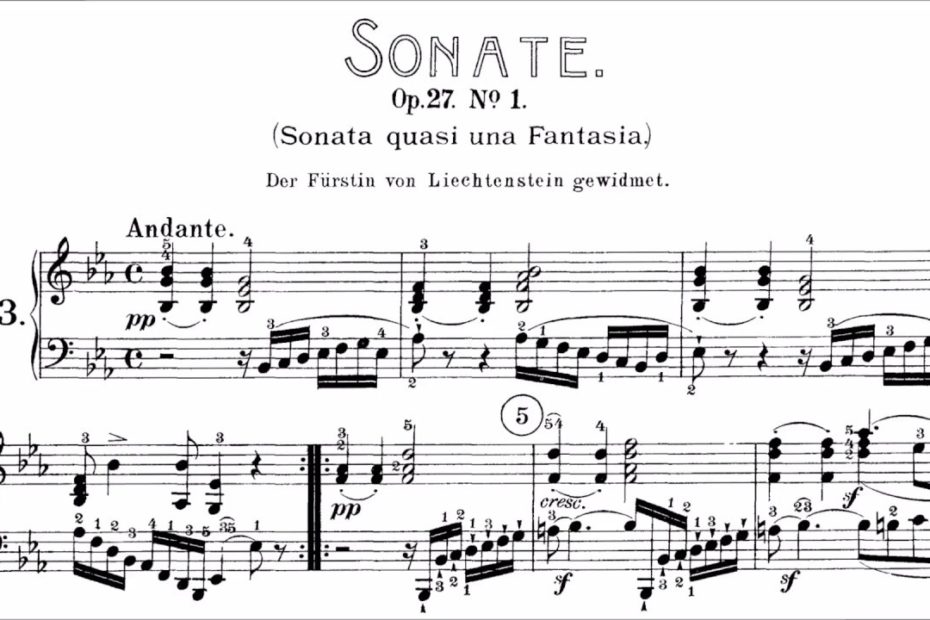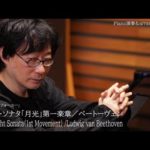Even by his own genre-busting standards, B. went through something of an experimental phase in his Op.26 and Op.27 sonatas, and this one, the Op.27 No.1, represents the most striking product of that period. Everyone who’s ever played it loves it, but it’s otherwise slightly obscure, and does not appear immediately striking. But that’s really part of its design, where B. takes the archetypically argumentative form – the sonata – and gives in a basically narrative (fantasy-like, improvisatory, episodic) character.
So there’s no gaps between all the movements, which are arranged in fast-slow-fast-slow order. Motivic connections are sparse. Each movement fills in an expressive gap the previous one lacks. The first is graceful, the second restless/ominous/fidgety, the third inward, the last celebratory and a bit silly. Not a single movement is in sonata form. Moods change constantly.
The first movement begins with an absurdly simple, almost trivial melody. The only thing that undermines its total naivete is the careful articulation B. indicates and the constant changes in sonority which animate it. The C section is such a ridiculous contrast to this it almost seems like a new movement, though its C maj harmony has already been beautifully anticipated.
The second movement is, again, an exercise in articulation, with distinctly improvisatory chord sequences and some of B.’s most creative textural writing in the return of the scherzo. It’s one of those weird movements that can be interpreted a million ways and emerge unscathed.
The third movement barely deserves the name – a single melody in three parts. And yet it returns at the end of the dizzy and already-large final movement, a sudden injection of sincere feeling into an ingeniously wrought rondo (the development section is pretty awesome) full of orchestral timbres.
MVT I, Andante – Allegro – Andante. Eb Maj. ABACA (or ABA) form
00:00 – A SECTION. Extremely simple melody with two strains. Intricate articulation. Note short-short-long rhythm.
01:02 – B SECTION. New sonority (and in second strain, sudden bright new harmony in C maj which turns out to be dominant of (ii)), with same short-short-long rhythm.
02:08 – A SECTION, with very slight variation.
03:11 – C SECTION. Violently contrasting in C maj, with quick runs and arpeggios pausing eventually on the dominant of Eb.
03:50 – A SECTION. Identical to opening bars, but now with inversions in double counterpoint.
4:54 – CODA, using the same rhythm of the opening, now with its last beat missing.
MVT II, Allegro molto e vivace. C min. Scherzo and trio
05:27 – SCHERZO. Arpeggios with bass initially descending in semitones, eventually closing on a chain of suspensions. Note B.’s initially puzzling placement of the repeat sign “one bar late”, which actually indicates the first bar functions as a kind of upbeat.
06:04 – TRIO. Persistent LH iambic rhythm, with playful syncopation in RH
06:32 – SCHERZO. The repeat at 6:39 features some of B.’s most imaginative textural writing, with legato syncopations above staccato bass
06:56 – CODA.
MVT III, Adagio con espressione. Ab maj. Single melody with three parts, functioning as introduction to last movement.
07:12 – Melody, Strain I
08:09 – Melody, Strain II
08:59 – Melody, Strain III (repeat of I with variation in accompaniment and harmony). Closing on dominant of (V)
MVT IV, Allegro vivace. Eb maj. Sonata-Rondo (ABACABCoda*), with development as second episode.
10:26 – THEME, Strain I. Strain II at 10:35.
10:48 – Transition, based on Theme. Second bar of Strain I developed in sequence
10:58 – EPISODE 1, in (V), moving into unexpected territory such as the dominant of Ab. Note the B-C-A-Bb motif, which will recur. A new cadence-theme arises at 11:14.
11:36 – Theme
11:50 – EPISODE 2 / DEVELOPMENT. Repetition of Theme, Strain II in tonic minor, closing on dominant of Gb
11:57 – Theme, Strain I emerges in bass, with new closing continuation. This 3-bar group is heard 4 times in double counterpoint, with accompaniment suggesting original semiquaver running bass. Db maj, Gb maj, Bb min.
12:10 – The new closing continuation is reduced to 3 notes, descending in imitative sequence, then in 3-note groups cutting across 2/4 rhythm.
12:18 – 2-bar dramatic close in Bb min, then repeated in diminution.
12:24 – Repeated Bbs become accompaniment to the main chromatic idea of Episode 1(!). The Bbs (Eb min) become Gbs (Cb maj), then Ebs (Ab min) which rise again to Bb.
12:48 – THEME
13:07 – Transition, moving now to dominant
13:17 – EPISODE 1, in tonic
13:48 – CODA. Extension of Episode 1’s cadential theme, now in a more celebratory mood.
14:03 – The Adagio’s Strain III returns(!) in the tonic.
15:34 – The closing presto. Theme, Strain I is elaborated on in highly compressed form in a 4-bar phrase, which is then repeated an octave higher with added thirds. At 15:41 Episode 1’s main motif returns in both RH and LH, together with a very compressed version of Strain I.




